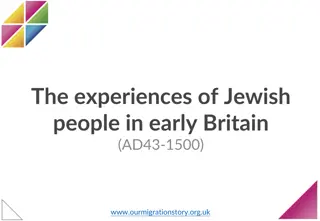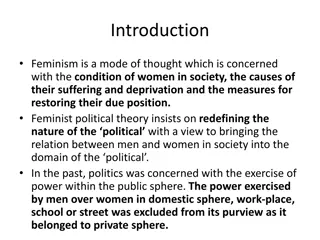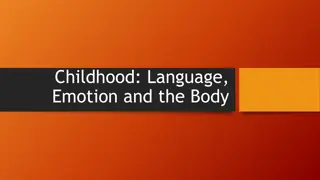Childhood in England (500-1500): Legal, Social, and Cultural Constructs
Exploring the constructs of childhood in England during 500-1500, this historical account delves into legal definitions, marriage customs, and social norms that shaped the lives of children during that period. From legal responsibilities defined by age to marriage practices and societal expectations, the text sheds light on how childhood was perceived and regulated in medieval England.
Download Presentation

Please find below an Image/Link to download the presentation.
The content on the website is provided AS IS for your information and personal use only. It may not be sold, licensed, or shared on other websites without obtaining consent from the author. Download presentation by click this link. If you encounter any issues during the download, it is possible that the publisher has removed the file from their server.
E N D
Presentation Transcript
Constructs of Childhood in England c500-c1500 Dr Toby Purser University of Northampton
Was there such a thing as childhood? Up till now it happened that the child which lay in the cradle, although it had never tasted food, was reckoned by avaricious folk as being guilty as though it had discretion. (Laws of Cnut, King of England, Denmark and Norway, c1020s)
Legal definitions A child was to be baptised within 30 days (Laws of Ine, c690) A ten year old boy was liable for theft (Laws of Ine); this also meant he could be executed (the age of ten is still the age of criminal responsibility in the UK today, 2021) This is raised to the age of twelve in the Laws of King Athelstan (c930) A later law code of Athelstan declared that after speaking with his councillors, the king decided that it seemed too cruel that a man should be killed so young, so in future no man younger than fifteen should be killed unless he tries to defend himself or fled. But if he offends again, he is to be executed. The Laws of Cnut (c1020s) explicitly state that every man over twelve years is to give an oath that he will not be a thief. thus defining the age of adulthood for the rest of the Middle Ages.
Marriage and sex Illegitimate children were to be identified in law (Laws of Ine, c680s) If the father of a child died, the mother is to raise the child with maintenance support (6 shillings, a cow in summer and an ox in winter) from the paternal family until the child is grown up (it does not state the age) There is a reference to the children s nurse, in Ine s laws If a pregnant woman is killed, and the child dies, it is worth half the value of its father s wergild. (Laws of King Alfred, c880s) A man may fight without incurring a vendetta if he finds another man in bed with his wife, or his daughter or his mother (Alfred s Laws) If a betrothed woman commits fornication, compensation is liable, according to her status (Alfred s Laws) Incest and rape were punishable by fines but if a woman commits adultery, she is to lose her nose and ears. (Cnut s Laws, 1020s) A widow and maiden were not forced to marry against their will though; after 12 months a widow could marry whom she wished.
Social custom Although the age of twelve is the legal age of criminal responsibility, 21 was the age of inheritance. Marriage was conducted at any age (betrothal could be between infants); the marriage ceremony conducted when they were of age (unspecified) and consummated when the girl was ready King John famously abducted a nine year-old girl, Isabella, in 1203, and married her. (They had children a few years later). Margaret Beaufort married Edmund Tudor when she was twelve (in 1455) and bore him a son at thirteen.
Work and play Children worked in the fields from the age of five or six Adolescence began at fourteen They were apprenticed/entered university at fourteen, graduating MA or Master at twenty-one Children of the aristocracy were sent away aged ten to households to serve great lords before gaining knighthood Others were given to the church as young as seven as novices.
Conclusion There was such a thing as childhood but it had several overlapping layers legal, social and sexual (just like today) Parents loved their children as much as we do, despite the near 50% infant and child mortality rate: one story illustrates this nicely: Finally, in 1292 Adam and Cecilia went to the pub for a drink, and their children played in the garden just like children do. One of the boys, John, pushed a girl, Joan, into the pond to frighten her (as boys do) and she fell in. John told the adults who rushed to the pond grief-stricken at what they thought was their dead daughter and pulled her out, identifying her by her little red shoes. Fortunately, she revived and it was a happy ending but it tells us how much they loved their daughter and the little red shoes is touch of humanity that echoes across the centuries.
References English Historical Documents: volume 1: c.500 1042, ed. D. Whitelock (2nd ed. 1979), pp.364-388; pp.419-430. H. Cunningham, The Invention of Childhood (2006). pp.40-41. N. Orme, Medieval Children (2001).























